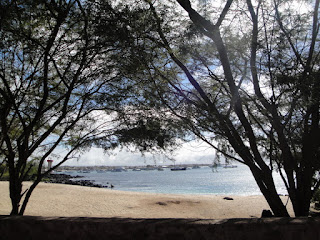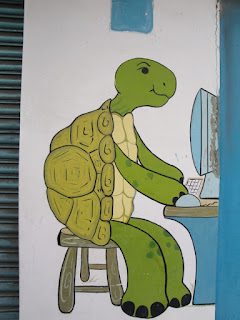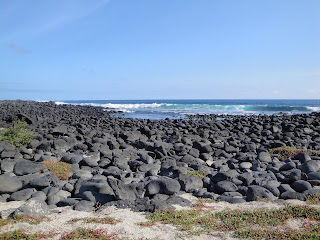San Cristobal Island, Galapagos Islands
San Cristobal Island is one of the Galapagos Islands and its main town, Puerto Baquerizo Moreno, is the capital of all the islands. The island is connected to Quito and Guayaquil by air and to some of the other islands by boat. Some cruises start from here. It has a population of about 6,000 and most of the adult males are fishermen.
Total Pageviews
Thursday, March 7, 2013
Tuesday, November 29, 2011
NEGF Online Shop
Support the New Era Galapagos Foundation by shopping in the NEGF online shop.
Labels:
NEGF,
NEGF online shop,
NEGF shop,
New Era Galapgos Foundation
Thursday, April 21, 2011
Managing Marine Tourism
Click on Managing Marine Tourism to find about more about the sustainable development of marine parks.
Monday, December 13, 2010
Pack for a Purpose
Improving the Lives of Children Five Pounds at a Time
Pack for a Purpose is a simple concept that makes a big impact on the lives of children around the world. Getting involved is easy. The organization is dedicated to providing information so individual travelers can bring needed educational materials and medical supplies to children in the communities they are visiting.
World travelers and entrepreneurs Rebecca and Scott Rothney with the help of several friends launched the website www.packforapurpose.org in December 2009. The organization was founded on the principal that every little bit helps and all it takes to get involved is to use a small amount space in your luggage for supplies when packing for a trip abroad.
When travelers visit the site they follow four simple steps. The first step is to select their destination. They then find their lodging which lists the sponsored community project and the needed supplies. Next they choose which supplies they wish to bring with them. 5 pounds is recommended. Last they pack them in their luggage and deliver them when they arrive at their lodging. Each listing on the Pack for a Purpose Web site has been contacted about the program, provided the needs list, has agreed to participate and will eagerly welcome all contributions from travelers.
“Five pounds can be as much as 400 pencils or five deflated soccer balls,” said Rebecca Rothney. “The first time we took supplies, we visited a local school in Botswana and the kids were playing soccer with a ball of rags tied together with string. It’s startling to see just how little some of the schools and clinics have to work with. I believe we can all find a little space in our luggage for a bag of supplies. If enough people make small contributions, we have the potential to make an enormous positive impact.
One of the first contacts Rothney established for the program was Michelle Puddu of Wilderness Safaris in South Africa. Rothney and her husband had personally worked with Puddu to bring many hundreds of pounds of school supplies to South Africa and Botswana over the course of several different trips.
“The idea is a brilliant one – it costs almost nothing on the part of the donor, just a great deal of kindness and a small amount of effort,” Puddu said. “This is the type of goodwill that nobody really thinks about, but makes a big difference.”
“As word spreads and more travelers participate, we have the potential to deliver several tons of needed supplies each year directly to the people who need them.” Rothney said. “Everyone wants to make a difference, vacation travelers, honeymooners and business travelers, and the Pack for a Purpose website will make it easy to contribute in a meaningful way.”
For Non-government Organizations
Lodgings, resorts and hotels provide us with information about the service projects they support, including a list of supplies they need. This information is then posted on our website. It is used to inform travelers about opportunities to assist the communities they visit by packing up to five pounds (2.2 kilos) of requested supplies in their luggage. Travelers then leave the supplies at the lodging, to be delivered to the sponsored community project.
There is no cost to participate, and the benefits are limitless! It only takes a few minutes to go to the “Contact” page on our website, enter in the necessary information in the “To Submit A Lodging” form, and become part of the Pack for a Purpose® network (http://www.packforapurpose.org/docs/contact.shtml). Not only will you receive free publicity for your property, but you will inform travelers about supplies needed to support your worthwhile projects.
For more information, please feel free to explore our website, http://www.packforapurpose.org/. All of the destinations that we are affiliated with to date are posted there, and are valued partners in their communities. We have received news and editorial coverage in a number of media, including ABCNews.com (http://abcnews.go.com/Travel/pack-purpose-helps-needy-africa/story?id=9744358&page=1), the International Ecotourism Society (http://www.yourtravelchoice.org/2010/03/making-a-difference-five-pounds-at-a-time/) and page 37 of Virgin Blue’s May 2010 in-flight magazine (http://voyeur.realviewtechnologies.com/?iid=35082). To see additional coverage, please visit the “News” page on our website (http://www.packforapurpose.org/docs/news.shtml).
We hope you will choose to become part of the Pack for a Purpose® network of projects and destinations. Doing so will not only enhance your web presence, but most importantly will benefit the worthwhile projects you support in your local communities!
Should you have any questions, please contact me at info.packforapurpose@gmail.com.
Monday, October 11, 2010
Books, Art and Artists
1 Art made from recycled paper by German Puente
Outlet in airport
2 Jacqui and Fabo Vazquez
Galeria a Man
Casa Blanca
Malecon
Link for Casa Blanca
3 Dusting the Past. Prof. Marco A. Zurita. Baquerizo M. Harbour, San Cristobal: Publipress, 2008.
History of the island, with photos.
On sale in German Puente Outlet in airport
4 Second-hand Books and Book Exchange
a Patagonia Cafe on Malecon
b Mockingbird Cafe, on side street off Malecon
c New Era Galapagos Foundation
On side street, off Malecon
5 Hermann Brandt
Brilliant paintings of fauna
Outlet in airport
2 Jacqui and Fabo Vazquez
Galeria a Man
Casa Blanca
Malecon
Link for Casa Blanca
3 Dusting the Past. Prof. Marco A. Zurita. Baquerizo M. Harbour, San Cristobal: Publipress, 2008.
History of the island, with photos.
On sale in German Puente Outlet in airport
4 Second-hand Books and Book Exchange
a Patagonia Cafe on Malecon
b Mockingbird Cafe, on side street off Malecon
c New Era Galapagos Foundation
On side street, off Malecon
5 Hermann Brandt
Brilliant paintings of fauna
Friday, October 8, 2010
Thursday, October 7, 2010
Friday, October 1, 2010
Tourist Information Centres
ITUR - Direction of Local Tourism
Avenue Charles Darwin
In front of ecotourist pier
San Cristobal
Tel: (593) 2521-166 extension 120
Galapagos Chamber of Tourism
Avenue Ignacio Hemandez y 12 de Febrero
Tel: (593) 2520-592
Avenue Charles Darwin
In front of ecotourist pier
San Cristobal
Tel: (593) 2521-166 extension 120
Galapagos Chamber of Tourism
Avenue Ignacio Hemandez y 12 de Febrero
Tel: (593) 2520-592
Wednesday, September 29, 2010
Maps of Islands
Main Tourist Sites
Cerro Brujo
Cerro Brujo is one of the nicest beaches in the northeast end of the island. It has sea lions and blue-footed boobies, great egrets and blue herons.Cerro de Las Tijeretas (Frigatebird Hill)
Cerro de Las Tijeretas is a hill beside the Interpretation Centre and has walkways with cacti and shrubs. One trail goes to a bay where there is good snorkeling. A huge statue representing Charles Darwin overlooks the bay.El Junco
El Junco is a freshwater lagoon inside a dormant volcanic crater. It is near the village of El Progresso and may be reached by buses or taxis from town. Manuel J. Cobbs had a sugar cane plantation here.
El Progreso
El Progreso is in the highlands above the town and is in the farming area of the island. The tomb of Manuel J. Cobos can be found here, along with ruins showing his attempts at developing farmland. The old Ingenio Azucarero Sugar Mill may be reached by means of a 45 minute carriage ride and a horse ride reaches La Soledad, where there is a stone church and observatory.
Galapaguera de Cerro Colorado
Galapaguera de Cerro Colorado is a tortoise breeding station about 40 minutes by taxi from the town. It was built by the Galapagos National Park with the support of the local government, the municipality and Araucaria XXI of the Spanish International Cooperation and Development Agency. There is a 900 metre long trail beside areas where giant tortoises may be found. The Jacinto Gordillo Rearing Centre facilitates the reproduction of giant tortoises in semi-captivity by means of incubators and climatising chambers. It is used for courses, workshops and community gatherings. Environmental interpretation panels guide visitors throught the centre and tell the story of giant tortoises on San Cristobal Island.
Source: Galapaguera of Cerro Colorado brochure
Interpretation Centre
The Interpretation Centre was built in 1998 and is located in the northern edge of the town. It has 3 independent buildings connected by walkways, showing the history of the island and its inhabitants.
Islas Lobos
Islas Lobos is located about an hour´s boat ride north east of the town. It has sea lions and blue-footed boobies. Lava lizards may also be found here.
Jardin de las Opuntias
Jardin de las Opuntias is situated in the arid zone, has cacti and mangroves, and is good for snorkelling.
La Loberia
La Loberia beach is located near the airport and is about 40 minute walk from the town. Land iguanas and birds may be found here, or you can surf, sunbathe or swim.
Las Negritas
Las Negritas is a nesting zone for 2 species of frigate birds.
Leon Dormido (Kicker Rock)
Leon Dormido looks like a sleeping lion and is a rocky islet near San Cristobal. It can be reached by a half-hour boat trip from the town. There is a channel between the two parts of the island, and you can swim with eagle rays, stingrays, sharks, and sea lions there.
Los Galapagos
Los Galapagos is in the northern end of the island where giant tortoises can be seen in the wild. It can be reached by a boat trip and walk, or by following a path from El Junco Lagoon.
Ochoa Beach
Ochoa Beach is in the northwest and is good for snorkeling. It has sea lions, frigate birds, pelicans and blue-footed boobies.
Playa de Los Marinos
Playa de Los Marinos is opposite the coastguard station. Many sea lions may be seen on this beach.
Playa Mann
Playa Mann is a short walk from the main part of the town. Here you can swim and snorkel with sea lions and watch iguanas.
Puerto Chino
Puerto Chino is about 45 minutes from town and is suitable for swimming and bird watching. It can be reached from El Junco.
Punta Carola (Beach of Love or Playa del Amor)
Punta Carola has world-class surfing and good snorkelling.
Punta Pitt
Punta Pitt is the northeasternmost point of the island and has volcanic tuff formations. The three species of Galapagos boobies can be found here.
Quinta al Ceiba
Quinta al Ceiba has a large tree-house and is situated in El Progreso.
Rancho Voluntad de Dios
Rancho Voluntad de Dios is an area in the highlands in Cerro Verde, near the Galapaguera. It has a restaurant and sports activities.
Tranquila
Tranquila is an area suitable for horse riding, mountain biking, camping and visiting small lagoons. Boobies may be found here.
Tortuga Bay (Turtle Bay)
Tortuga Bay is also in the northeastern part of the island and turtles may be seen here.
Sources:
Ecuador and the Galapagos Islands. Lonely Planet.
Guia Informativa Turistica.
Revisita-guaia bilingue Galaquil.
Independent Traveler Galapagos Handbook. Guayaquil, Ecuador: Flying Fish Publications, 2000.
Link:
Interactive Guide
Tuesday, September 21, 2010
History of the Galapagos
San Cristobal island used to be called Chatham, and was given this name in 1793 by Captain James Colnett, to honour William Pitt, the first count of Chatham.
Charles Darwin visited the island in 1835, landing at Cerro Tarjetas.
Later, Manuel Cobos established a sugar refinery in El Progreso.
http://www.geo.cornell.edu/geology/GalapagosWWW/GalapagosHistory.html
Charles Darwin
C Darwin
Early Explorers
Charles Darwin visited the island in 1835, landing at Cerro Tarjetas.
Later, Manuel Cobos established a sugar refinery in El Progreso.
http://www.geo.cornell.edu/geology/GalapagosWWW/GalapagosHistory.html
Charles Darwin
C Darwin
Early Explorers
Thursday, September 16, 2010
Information about San Cristobal and Other Islands
Geology
It is a volcanic island, divided into 2 sections: the northwest, which is the product of young volcanism, and the southeast, formed by ancient volcanism. The inhabited area was formed by a collapsed volcano that is believed to be 5 million years old.
Human History
San Cristobal island was the first island that Charles Darwin landed on in 1835. A sugar refinery and plantation was started and run by Manuel J. Cobb in El Progreso in the mid 19th century. The ruins may be found at the entrance to the village. More information about the island´s history may be found at the Interpretation Centre.
Links
Come to Galapagos
Caturchrist
Vive Ecuador
Ecuador Tourism
Tourism
Ecuador Travel
Galapagos Tour
Galapagos Park
Isabela Island
Santa Cruz Municipality
INGALA
Monday, September 13, 2010
Eco Scout and Environmental Activities
Subscribe to:
Posts (Atom)


































